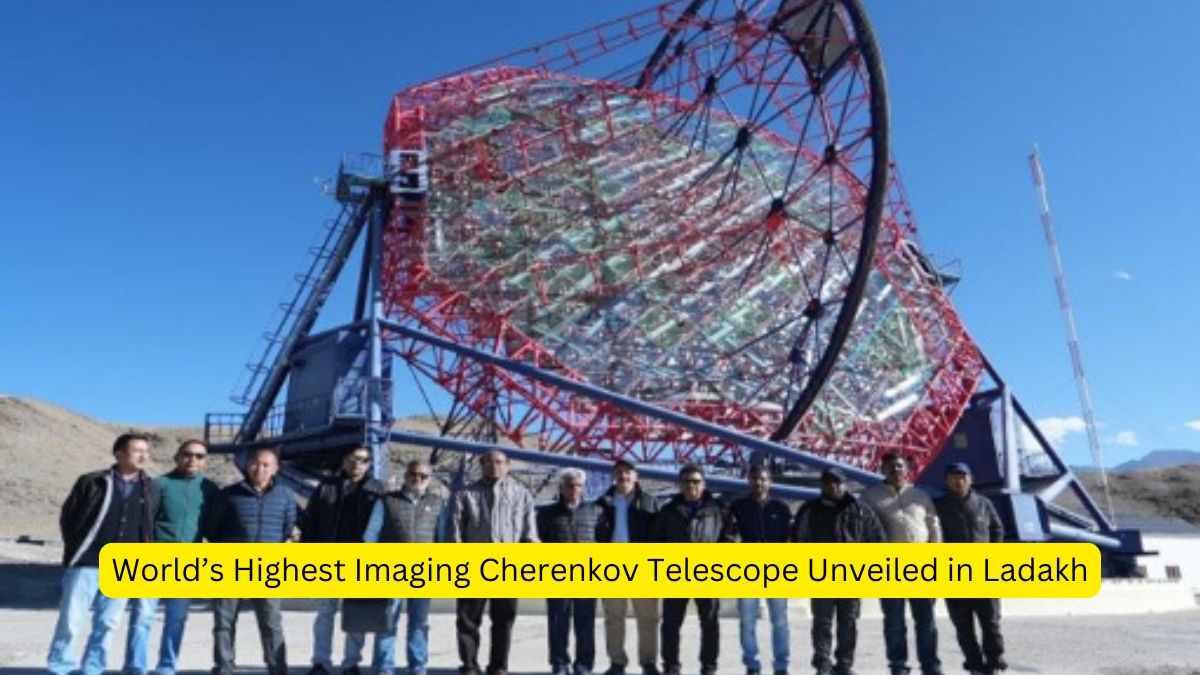On October 4, 2024, Dr. Ajit Kumar Mohanty, Secretary of the Department of Atomic Energy (DAE) and Chairman of the Atomic Energy Commission, inaugurated the Major Atmospheric Cherenkov Experiment (MACE) Observatory in Hanle, Ladakh. This monumental facility is the largest imaging Cherenkov telescope in Asia and stands as the highest of its kind in the world, located at an altitude of approximately 4,300 meters.
Built indigenously by the Bhabha Atomic Research Centre (BARC) with support from Electronics Corporation of India Limited (ECIL) and other Indian industry partners, MACE represents a significant achievement in India’s pursuit of advanced astrophysical research. Its inauguration coincides with the Platinum Jubilee celebrations of the DAE, symbolizing a robust commitment to scientific advancement.
Location
- MACE is situated at around 4,300 meters in Hanle, Ladakh, making it the highest imaging Cherenkov telescope in the world.
- Its elevated position allows for optimal observations of cosmic phenomena free from atmospheric interference.
Focus on High-Energy Gamma Rays
The telescope will primarily observe high-energy gamma rays, providing insights into some of the universe’s most energetic phenomena such as Supernovae, Black Holes, Gamma-Ray Bursts.
AIM
- MACE project aims to foster international collaborations, advancing India’s contributions to space research and bolstering India’s position in the global scientific community.
- The observatory will also serve as a beacon of inspiration for future generations of Indian scientists, encouraging them to explore new frontiers in astrophysics.
Key Highlights of the Inauguration
Inaugural Ceremony
- The event commenced with Dr. Mohanty’s arrival at the observatory site, where he unveiled commemorative plaques to officially inaugurate MACE. Dignitaries present included Dr. S. M. Yusuf, Director of the Physics Group at BARC; Shri A. R. Sule, Additional Secretary of DAE; Prof. Annapoorni Subramanian, Director of the Indian Institute of Astrophysics (IIA); and Shri Sajjad Hussain Mufti, Chief Conservator of Forests, UT Ladakh.
Dr. Mohanty’s Inaugural Address
- Dr. Mohanty praised the collective efforts that brought MACE to fruition, calling it a monumental achievement for India.
- He articulated that MACE will facilitate the study of high-energy gamma rays, contributing to the understanding of the universe’s most energetic events.
- He also acknowledged the contributions of Dr. Homi J. Bhabha, whose legacy continues to inspire Indian cosmic-ray research.
- Dr. Mohanty expressed hope that MACE would inspire future generations of Indian astronomers, scientists, and engineers.
- He recognized local leaders and community representatives for their support, highlighting the significance of collaboration in scientific advancements.
- The dignitaries released a pictorial compilation documenting the MACE project’s journey, and Dr. Mohanty honored the village leaders and the local community’s contributions.
Significance of MACE
- In his address, Dr. S. M. Yusuf emphasized MACE’s role in advancing India’s capabilities in space and cosmic-ray research.
- He highlighted the telescope’s potential to enhance understanding of high-energy astrophysical phenomena.
Balancing Science and Tourism
- Shri Ajay Ramesh Sule underscored the importance of maintaining a balance between tourism and scientific activities within the Hanle Dark Sky Reserve, encouraging students to pursue careers in science and technology.
Collaboration in Research
- Dr. Annapoorni Subramanian spoke about the successful collaboration between various DAE units and the IIA, which played a crucial role in the project’s realization.
Community Engagement
- Shri Sajjad Hussain Mufti outlined the features of the Hanle Dark Sky Reserve and emphasized the administration’s commitment to supporting DAE’s scientific endeavors through community engagement.
Interactive Sessions
- The ceremony concluded with a vote of thanks from Dr. K. K. Yadav, Head of Astrophysical Sciences Division of BARC, followed by a visit to the MACE Control Room, where dignitaries interacted with astronomers and technicians.
| Summary/Static | Details |
| Why in the news? | On October 4, 2024, Dr. Ajit Kumar Mohanty, Secretary of the Department of Atomic Energy (DAE) and Chairman of the Atomic Energy Commission, inaugurated the Major Atmospheric Cherenkov Experiment (MACE) Observatory in Hanle, Ladakh. |
| Facility MACE Observatory | Largest imaging Cherenkov telescope in Asia and highest in the world |
| Key Organizations Involved | Bhabha Atomic Research Centre (BARC), Electronics Corporation of India Limited (ECIL), Indian industry partners |
| Main Focus | High-energy gamma rays, observing cosmic phenomena like Supernovae, Black Holes, and Gamma-Ray Bursts |
| Project Aim | Enhance India’s contributions to space research and astrophysics, fostering international collaborations |
| Significance of MACE | MACE enhances India’s research capabilities in space and astrophysics, with a special focus on understanding high-energy astrophysical phenomena |




 India Plans New Antarctic Station Maitri...
India Plans New Antarctic Station Maitri...
 India Launches Its First 1.0 GHz, 64-bit...
India Launches Its First 1.0 GHz, 64-bit...
 ISRO Projects Seven Launches Including U...
ISRO Projects Seven Launches Including U...







